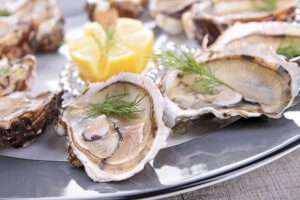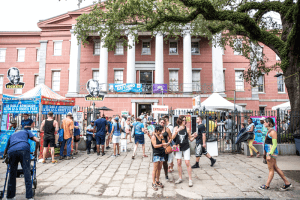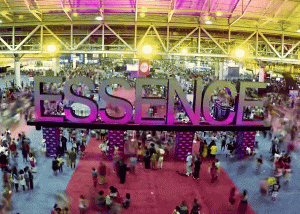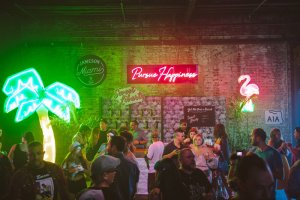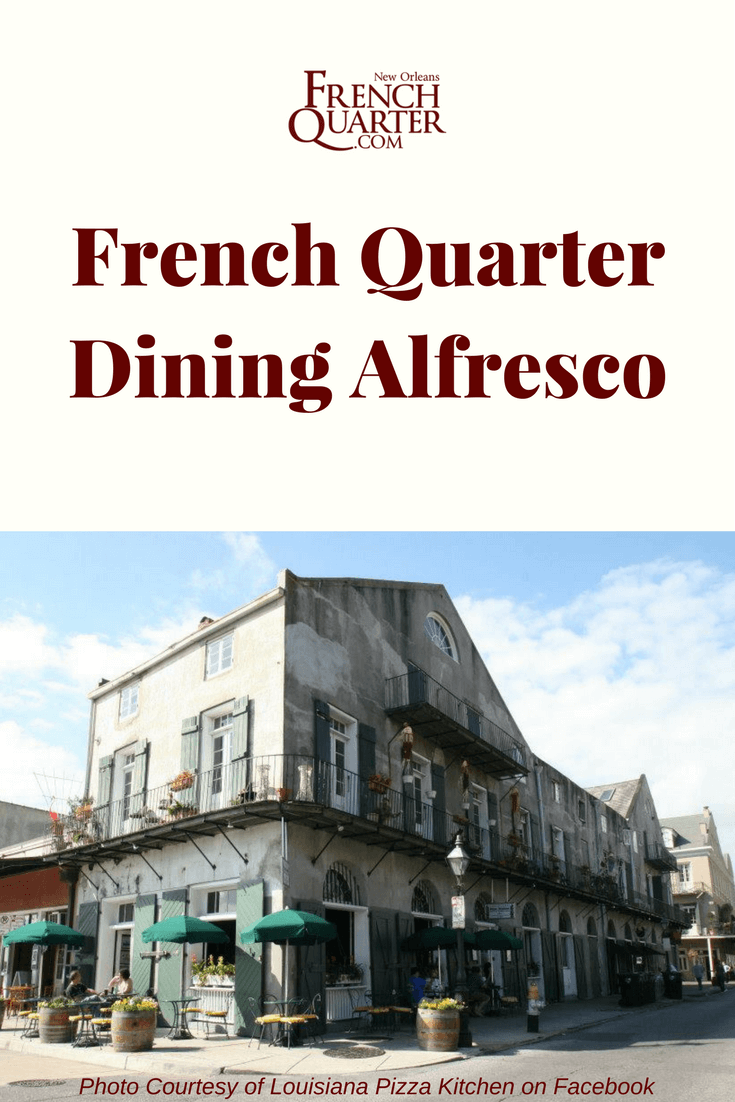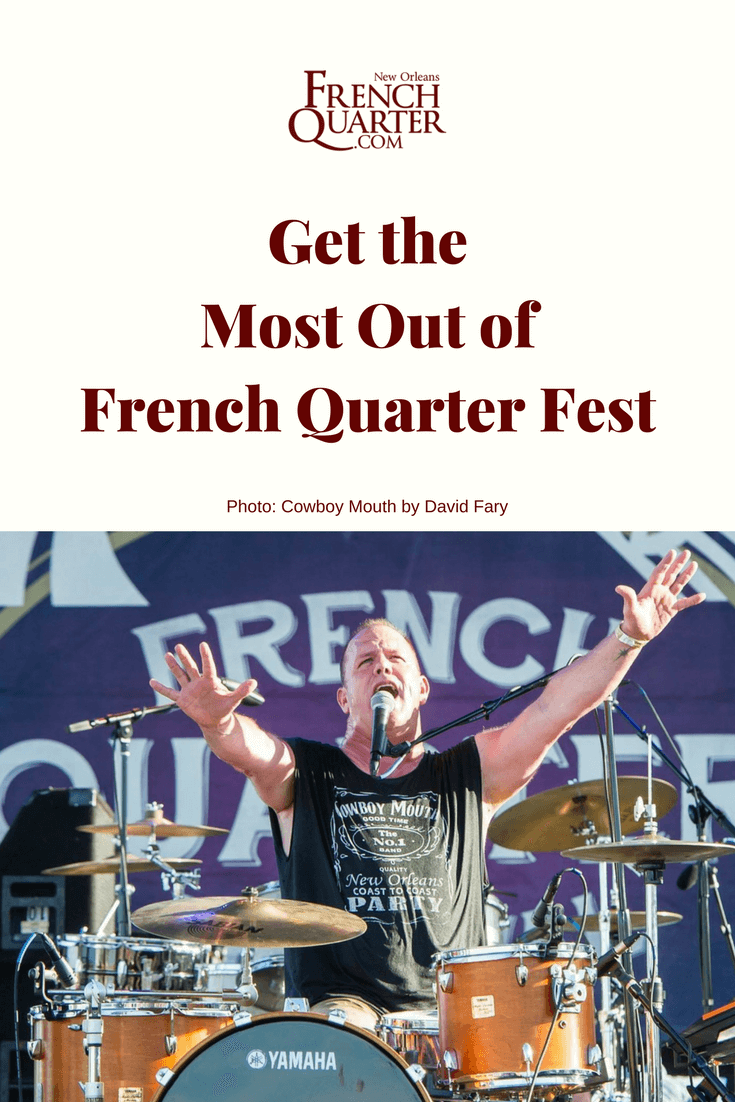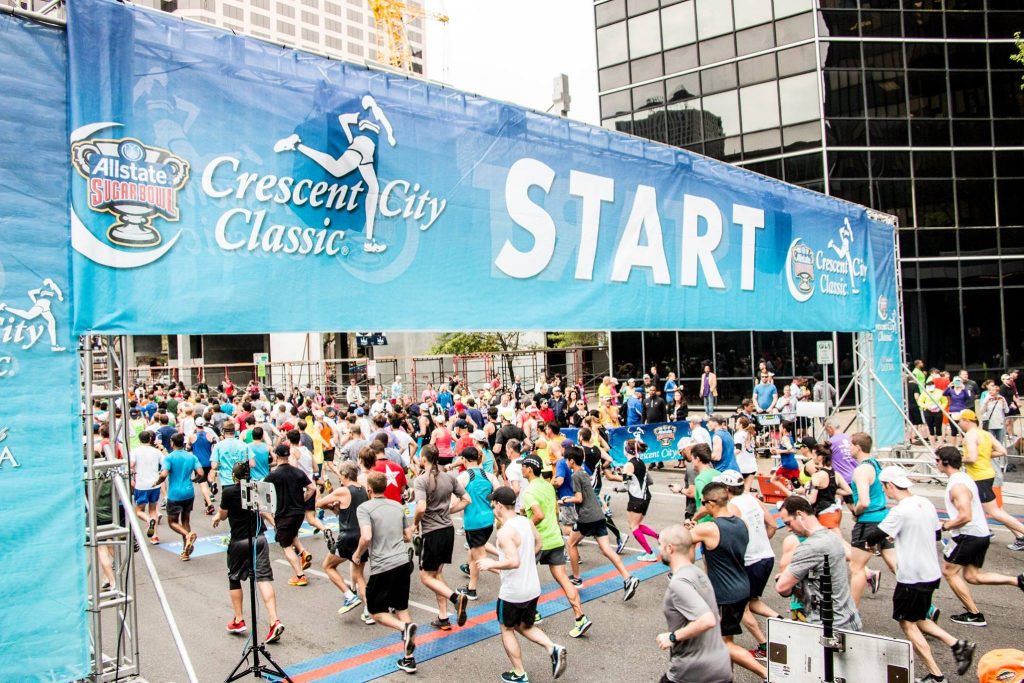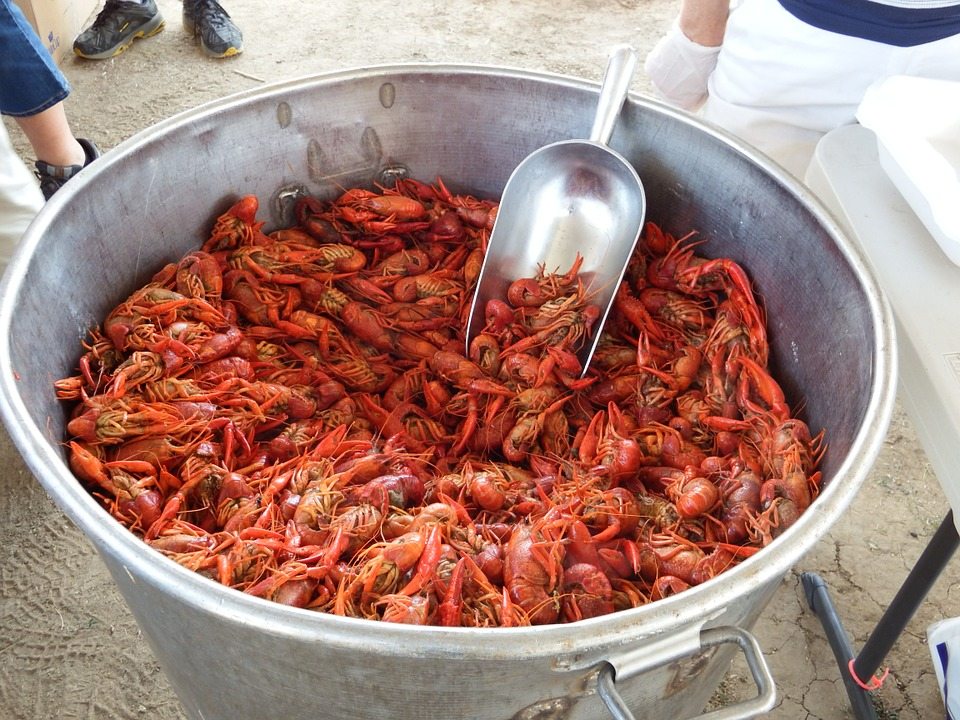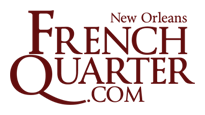June Festivals in New Orleans
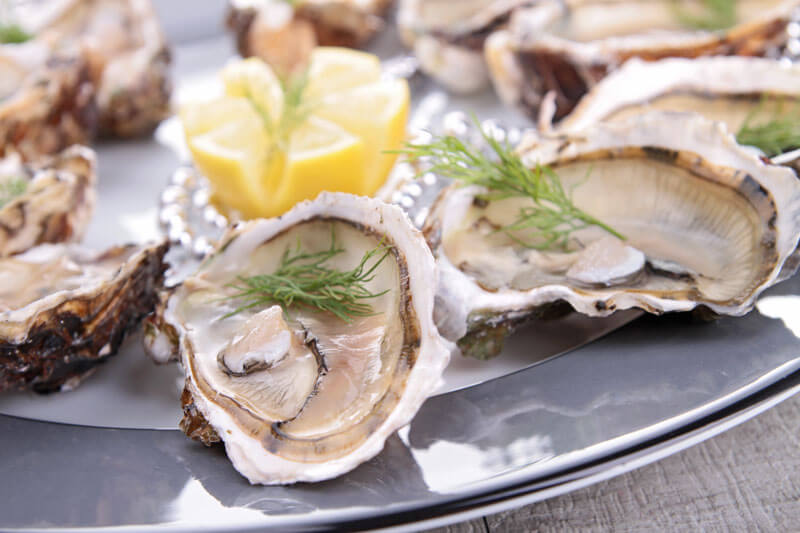
The end of spring and the beginning of summer in the French Quarter is packed with celebrations of local food, music, and culture — going well into August. Here are a few must-attend events happening in June in and near the French Quarter.
French Market Creole Tomato Festival
Saturday-Sunday, June 7-8, 2025
Traditionally held in early June, the annual (and free!) French Market Creole Tomato Festival welcomes the arrival of Creole tomatoes that Louisiana loves to incorporate into many local recipes. The French Market location and the food offerings make this a popular festival among locals and visitors alike.
Celebrating its 39th year in 2025, the festival features live music at the market and in Dutch Alley, kids’ activities, and a second line. There are cooking demos in addition to an extensive menu from participating food vendors of Creole tomatoes incorporated into gelato, crepes, crawfish pies — you name it. You can also get Creole tomatoes from the participating farm stands.
Kick off the Creole Tomato Festival with the Ripe & Ready second line on Saturday, June 7, at 10:30 a.m. It’s open to all, and you’re encouraged to wear “your favorite tomato attire.” The second line will form at Oscar Dunn Park, 700 Decatur Street across from Jackson Square, and walk to the French Market festival location. On both Saturday and Sunday the fest will be held from 11 a.m. to 5 p.m.
The festival is spread out between the tents and the stages located at the Farmers Market, the New Orleans Jazz Museum at the Old U.S. Mint (this one is indoors), and Dutch Alley. The live music schedule never disappoints.
New Orleans Wine & Food Experience
Wednesday-Sunday, June 11-15, 2025
In its 33rd year in 2025, the New Orleans Wine & Food Experience (NOWFE) is a smorgasbord of food and wine tastings, tours, master classes, and the annual champagne-soaked burlesque brunch. Each year, hundreds of wineries and restaurants participate, offering menus featuring local flavors and innovative new creations inspired by diverse cuisines.
Top chefs from around the city create unique culinary experiences, so much so that the event regularly makes a few national “best of” festival lists. The organization behind this popular event is a nonprofit that donates 100% of its proceeds to beneficiaries ranging from food banks to culinary schools. You can see all the events and get tickets online.
New Orleans Pride
Friday-Sunday, June 12-15, 2025
Launched in 2011, New Orleans Pride is a weekend-long celebration taking place in the French Quarter to celebrate and honor LGBTQ+ communities and their allies in New Orleans and surrounding areas. It is the only official Pride Festival in New Orleans, the largest in Louisiana, and one of the fastest-growing Pride celebrations in the nation.
Special events include the Pride Gala, the PrideFest block party at the Phoenix bar, and the annual parade. The parade rolls on Saturday, June 14, 2025, starting at 3 p.m. at the Armstrong Park and rolling through the French Quarter. The parade is family-friendly for all to enjoy.
Restaurant Week New Orleans
Monday-Sunday, June 14-20, 2025
During this time, you can enjoy multi-course, special menus and dining deals in numerous participating restaurants, from upscale Creole eateries to neighborhood bistros. Keep up with this year’s list of participating restaurants and their menus, and don’t miss a chance to try a new spot or revisit your favorite.
Father’s Day
Sunday, June 15, 2025
Though technically it’s not a festival, you can make it your own by honoring your dad! Take your dad to brunch, a museum, or just a walk at the Riverfront. Make your reservation soon, and enjoy the good food and fun this city has to offer!
New Orleans Juneteenth Festival
Thursday, June 19, 2025
Come to Congo Square in Armstrong Park to commemorate this remarkable date with this free festival, held from noon to 6 p.m.
Coming to New Orleans in June?
Check out our guide to where to stay in the French Quarter, and be sure to check out our resource for French Quarter Hotels. Also, consider booking a guided tour of St. Louis Cemetery No. 1 to experience the hauntingly beautiful past of New Orleans.
For easy, informative sightseeing, we recommend the City Sightseeing New Orleans city tour on the open-top, double-decker bus. It runs every 30 minutes through the Garden District, French Quarter, and CBD. You can hop on and off anytime!
Happy June!
Related Articles
JOIN THE NEWSLETTER!
Satchmo SummerFest Celebrates the Legacy of Louis Armstrong
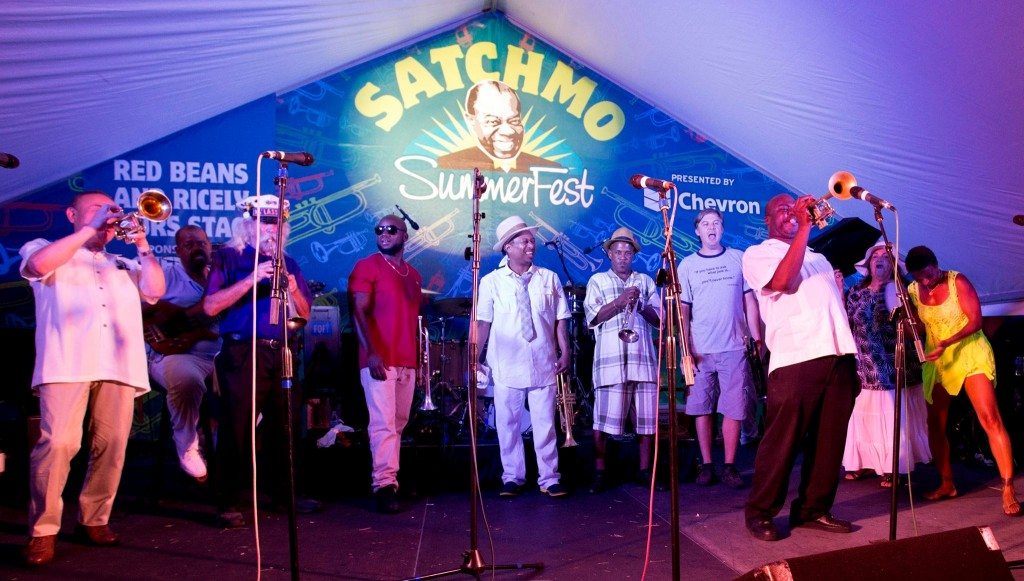
Photo courtesy of Satchmo SummerFest on Facebook
Satchmo SummerFest started in 2001 as a tribute to Louis Armstrong, one of New Orleans’ most prominent native residents, on his 100th birthday (“Satchmo” was one of Armstrong’s several nicknames). Ever since, the fest remains the August highlight and just the respite we need from the long weeks of summer.
The annual festival, traditionally held over the first weekend of August in the French Quarter (falling on Saturday, August 2, and Sunday, August 3, 2025, this year), is easy to navigate and get to. The fest will be spread on two stages at the New Orleans Jazz Museum (at the Old U.S. Mint).
While the 2025 music and vendor lineups are TBA, the always-stellar music lineup included in the past the Big 6 Brass Band, Treme Brass Band, Preservation Brass, Jeremy Davenport, Charmaine Neville, The Original Pinettes Brass Band, and more.
Among the festival’s traditional special events, the annual Jazz Mass will again be held at St. Augustine church (1210 Governor Nicholls St.) on Sunday, August 4, at 10 a.m. It’s a popular event, so arrive early if you plan to attend.
Immediately following mass, join the “Satchmo Salute” second line parade, which will make its way from the church to Armstrong Park before secondlining down to Esplanade Avenue and the festival’s grounds at the New Orleans Jazz Museum.
For schedule, lineup and updates please check the event’s website or its Facebook page.
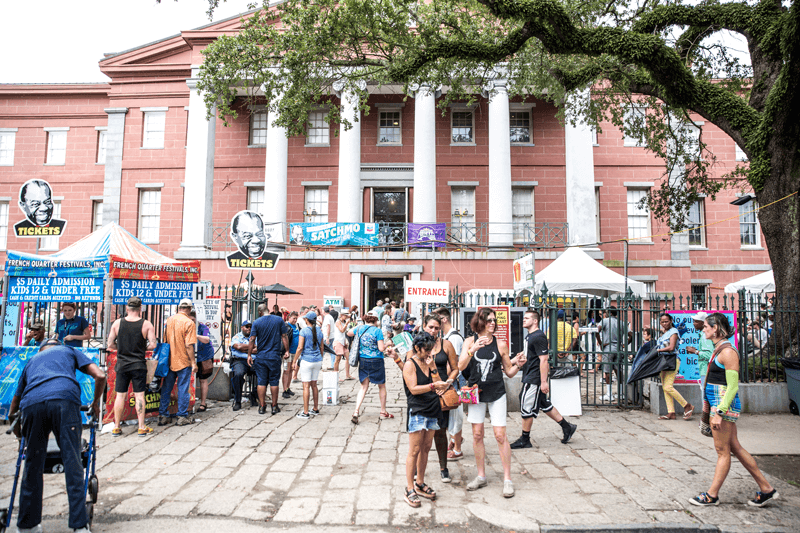
Photo courtesy of Satchmo SummerFest on Facebook
You may also want to know:
Admission is free.
There will be shaded picnic tables on the grounds for dining.
Parking: For street parking, you may want to look along the stretch of the French Market and at the foot of Esplanade Avenue. There is also a 24/7 parking lot by the French Market along the river. Enter from St. Peter Street.
Pops’ Playhouse for Kids at the Jazz Museum will have children’s activities.
No coolers or ice chests, and no outside food or drink, please.
Festival details:
What: The annual Satchmo SummerFest
When: Saturday-Sunday, August 2-3, 2025
Where: New Orleans Jazz Museum (at the U.S. Mint, 400 Esplanade Ave., French Quarter)
Admission: Free
Schedule and food vendors: https://satchmosummerfest.org/
Coming to New Orleans in August?
Check out our guide to where to stay in the French Quarter, and be sure to check out our resource for French Quarter Hotels. Also, consider booking a guided tour of St. Louis Cemetery No. 1 to experience the hauntingly beautiful past of New Orleans.
For easy, informative sightseeing, we recommend the City Sightseeing New Orleans city tour on the open-top, double-decker bus. It runs every 30 minutes through the Garden District, French Quarter, and CBD. You can hop on and off anytime!
Happy August!
Related Articles
JOIN THE NEWSLETTER!
Your Guide to the 2025 ESSENCE Festival of Culture
Over the years, the ESSENCE Festival of Culture has evolved into one of the largest celebrations in the country, and New Orleans is proud to host it again, when ESSENCE celebrates its 31st year in 2025. If you plan on attending, here’s our guide on how to navigate the festival, where to eat, shop and stay, and generally how to make your visit an unforgettable one.
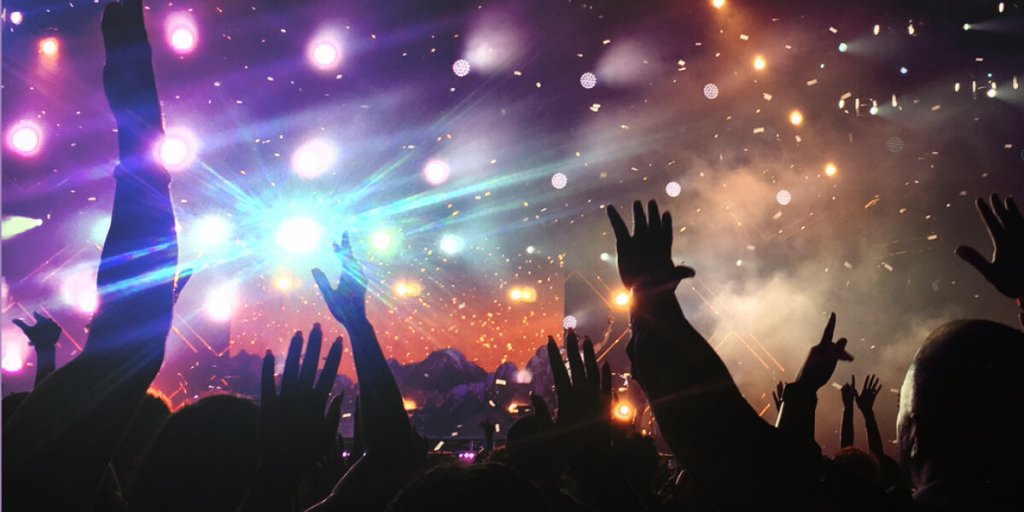
When and Where Is the ESSENCE Festival of Culture?
Traditionally, the ESSENCE Festival of Culture takes place over the Independence Day weekend. This year, the dates fall on July 3-6, 2025. Over the four days, the event will be held mostly at the two New Orleans venues: the Caesars Superdome for the evening performances and the New Orleans Ernest N. Morial Convention Center for the daytime activities.
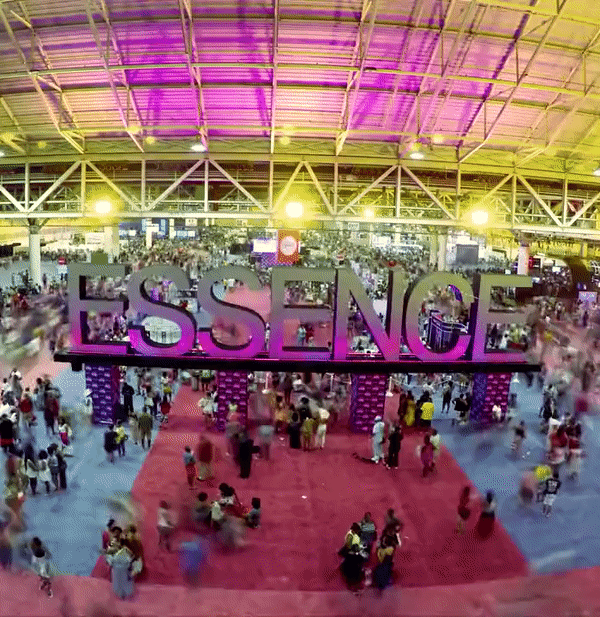
Music Lineup Headliners and Other Highlights
Music fans from all over simply can’t go wrong with all the incredible names in every year’s lineup. The 2025 theme is “Made Like This.” Notable performers include Boyz II Men, Jill Scott, Davido, Maxwell, Master P, GloRilla, The Isley Brothers, Nas, and Summer Walker. A tribute to Quincy Jones will be performed by Jermaine Dupri.
The traditional Sunday Gospel Celebration at the Convention Center features the greatest gospel hits, and ESSENCE After Dark, a series of late-night jam sessions, comedy shows, underground performances, live podcast recordings, and more, is also not to be missed.
In addition, a variety of exciting conferences, exhibitions, roundtables, and other experiences are scheduled this year, plus beauty, fashion, and food events, a marketplace, a family day, an economic forum, keynote speakers, and more. The BeautyCon and Wellness House experiences feature celebrity beauty influencers and wellness experts.
Where to Get Your Tickets
You can get your tickets a la carte (for the evening concerts at the Superdome and ESSENCE After Dark) or in bundled day and VIP packages, online. The headliners sell out fast, so don’t wait till the last minute! All the events held at the Convention Center during the day are free and open to all (registration is required for everyone over 18).
What to Pack
Bring comfortable shoes, an umbrella or rain jacket (as summer in New Orleans can bring unpredictable weather and frequent afternoon showers), and a lot of patience.
The Convention Center in particular is massive, so there will be a lot of walking, and lines could be long. Both the Superdome and the Convention Center have AC, of course, but staying Instagram-ready in the hot and humid New Orleans summer could be tricky.
So dress light, but also be prepared for the much chillier temps inside. It might be a good idea to bring a portable mobile device charger with you so you won’t have to look for an available power outlet in a crowded venue.
Where to Eat
Check out the ESSENCE Food & Wine experience while you’re attending the festival for dozens of vendors and special food demos to get recipe inspiration, find a new dish you like, or revisit an old favorite. There’s also a food court with vendors from all over the South offering a wide range of classic New Orleans food, world cuisine, vegan and vegetarian fare, desserts, and beyond.
For dining out on the town (and in the French Quarter in particular), see our guides, below.
Where to Shop
Look for the festival marketplace near the food court, with dozens of vendors selling artwork, crafts, music, clothing, jewelry, etc. You can easily get your souvenir shopping done there, too, from the local vendors. The festival also has its own store inside the Convention Center, with festival merch, books, magazines, and so on.
There are also plenty of shopping options in the area. You could spend a whole day browsing the three levels of The Shops at Canal Place. It has a soaring atrium and food options ranging from casual to upscale. Canal Place houses a slew of upscale national chains like Saks Fifth Avenue, Brooks Brothers, and Louis Vuitton, but also local boutiques.
The Outlet Collection at Riverwalk, located by the Mississippi River, is a sprawling discount outlet mall with all the popular labels like Gap, Under Armour, and Guess.
Further down, venturing into the French Quarter, check out H&M and Sephora, plus all the lovely, unique boutiques that pepper Chartres St.
For more shopping suggestions, please see our guides, below.
Where to Stay
If you plan on attending the ESSENCE Festival of Culture, why not choose a historic hotel for a unique experience? You’ll still stay close to all of the action and excitement, but you’ll also be creating memories steeped in history and charm.
Here are our suggestions: All these hotels are historic properties located in the French Quarter (three of those — Hotel St. Marie, French Market Inn and Place D’Armes — have charming saltwater pools in their lush courtyards).
Book your New Orleans stay with the help of our Recommended New Orleans Hotels.
What’s Going on in New Orleans That Week?
There’s Independence Day, of course. New Orleans celebrates July 4th like anywhere else in America, but also with a flavor all her own. There will be fireworks over the Mississippi River and plenty of music and partying. Head to the Riverfront for the display, or see if you can score a French Quarter balcony as a viewing (and party) spot. Many Bourbon Street bars with balconies allow access for a cover fee or if you’re just buying drinks.
What Else You Need to Know
- The ESSENCE Festival of Culture requires all guests 18 and over to register for entry into Essence Festival’s conferences and expos.
- Since the Convention Center events are for all ages, if you want to buy a drink at the food court, prepare to be carded.
- You can re-enter the Convention Center multiple times, but not the Superdome.
- No outside food or drink will be allowed at the Convention Center and the Superdome; all bags will be searched.
- Take note of the Superdome’s clear-bag policy: “Any bag, purse, or briefcase that is larger than 12” x 6” x 12” will not be allowed into the Superdome. All bags that enter must be clear, with the exception of medical bags, which may be subject to inspection, and small clutch bags. The maximum size for a clutch bag is 4.5”x 6.5”.”
- Look for the festival sponsor booths (like Coca-Cola) to score some samples and giveaways and to enter contests. Sponsor booths also host celebrity meet-and-greets, so this might be your chance to meet your favorite star when they’re not performing.
New Orleans and French Quarter Guides
Make the most of your stay in New Orleans while you enjoy ESSENCE Fest with our comprehensive guides to the New Orleans dining, sightseeing, shopping, nightlife, and much more:
New Orleans Guides
Eating and Drinking
- Local French Quarter Favorites
- Diet Another Day: New Orleans Must Eats in the French Quarter
- Best Food on Bourbon Street
- Best Kept Secrets for Eating Cheap and Eating Well in the Quarter
- Late Night Dining: Where to Turn in the Quarter When the Midnight Hungries Hit Hard
- Vegetarian Destinations in the French Quarter
- Best Pizza in the French Quarter
- French Quarter Dining Al Fresco
Classic New Orleans and Southern Dishes
- Try the Best Jambalaya in the French Quarter
- 10 Best Places to Get Gumbo in the French Quarter
- Where to Score the Best Crawfish in New Orleans
- Best Muffulettas in the French Quarter and Nearby
- New Orleans’ Po-Boy Is A Rich Food Tradition
- New Orleans’ Legendary Fried Chicken Joints
- The Best Barbecue in New Orleans
- Bananas Foster in the French Quarter
- Proof Is in the Bread Pudding
Cocktails
- The Best Happy Hours in the French Quarter
- Classic Cocktails and Modern Thirsts in the French Quarter
Shopping
- French Quarter Shopping: One-of-a-Kind Stores
- Vintage Shopping in the French Quarter
- Hat Shopping in the French Quarter and Nearby
- Shopping for Discovery and Surprise
Exploring
- First-Timer’s Guide to the French Quarter
- Must-See French Quarter Museums
- Must-See Mardi Gras Museums
- Photo Ideas for Your Next French Quarter Vacation
- What to Do on a Rainy Day in the French Quarter
- Fun New Orleans Sightseeing With the Hop-On Hop-Off Bus Tour
- Famous New Orleans Ghosts
- New Orleans’ Haunted History
- Neighborhoods Near the French Quarter
Famous Streets
- Bourbon Street: The Complete Block-by-Block Guide
- Bourbon Street Bucket List
- Decatur Street: Block-by-Block
- Royal Street, a Block-by-Block Guide
- Famous Streets of the French Quarter: North Rampart Street
- Famous Streets of the French Quarter: Chartres Street
Additional Resources
- The Ultimate Guide for Women Traveling Solo in the French Quarter
- What to Do in the French Quarter When You’re Under 21
- Exploring the French Quarter With Kids
Coming to New Orleans This Summer?
In addition to checking out our suggestions listed above, consider booking a guided tour of St. Louis Cemetery No. 1 to experience the hauntingly beautiful past of New Orleans. For easy, informative sightseeing, we recommend the City Sightseeing New Orleans city tour on the open-top, double-decker bus. It runs every 30 minutes through the Garden District, French Quarter, and CBD. You can hop on and off anytime!
Related Articles
JOIN THE NEWSLETTER!
Tales of the Cocktail Returns to New Orleans This Summer
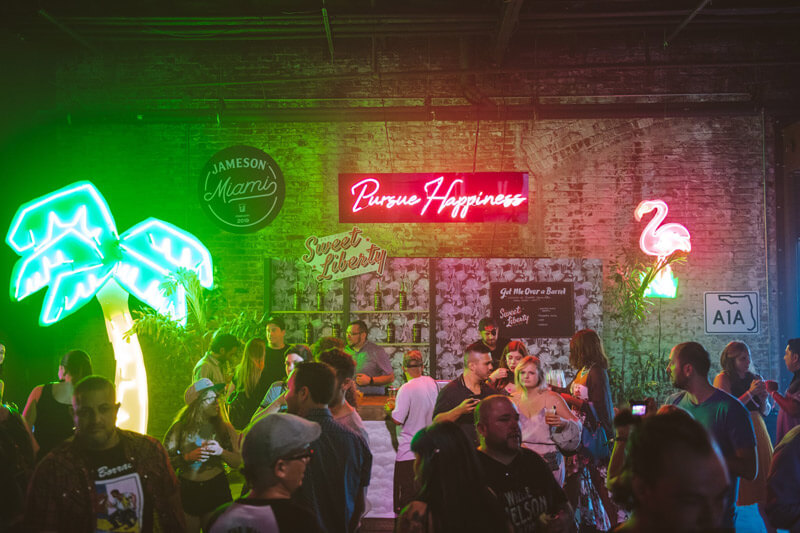
Tales of the Cocktail by Cory James Photo
Tales of the Cocktail Foundation‘s popular annual conference returns Sunday, July 20 – Friday, July 25, 2025, providing festival-goers with six action-packed days of tastings, special events, and scheduled seminars. This is a perfect chance for spirit enthusiasts from all over the world to create and exchange ideas and techniques in the cocktail world.
Developed for any and all spirit enthusiasts and professionals, Tales of the Cocktail gets the whole city involved with a variety of special events and celebrations throughout the week. Regardless of whether you are a bartender, bar owner, distiller, mixologist, tastemaker, or just a passionate lover of food and drink, Tales of the Cocktail is an event you will not want to miss.
Celebrating History With Every Sip
Some of the world’s most famous cocktails were invented in this city: the Sazerac, Brandy Milk Punch, and Ramos Gin Fizz, to name a few. This festival started as a walking tour of historic New Orleans cocktail bars, and now, celebrating 23 years in 2025, it attracts thousands of people from all over the world with dozens of events hosted over just six days (see the packed conference agenda here).
The focus of Tales of the Cocktail is to create a valuable experience for bartenders, distillers, ambassadors, and other members of the industry. The festival is constantly adapting to the needs of the industry by developing programming that allows participants to learn, network, and hone different skills. There’s a different theme every year, and the 2025 one is “Evolve.”
The festival features multiple seminars and tastings, and if you’ve ever wanted to explore the “spirited” side of New Orleans (drinks, not ghosts), there are multiple tours, happy hours, tastings, seminars, book signings, bartender contests, networking, and more.
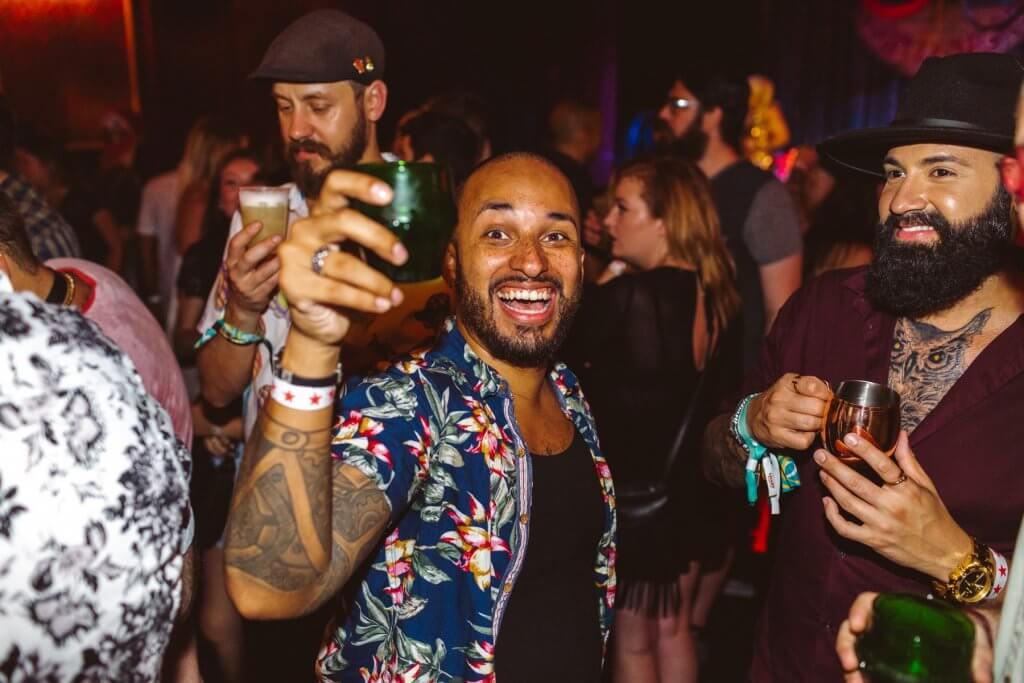
Tales of the Cocktail by Cory James Photo
More Than Just Drinks
Tales of the Cocktail highlights the important connection between two of our favorite subjects – food and drink – and to that end, the Spirited Dinner series will feature special cocktail and food menus at restaurants across the city. The Tales’ signature annual blowout, the “best of” Spirited Awards, will be held on Thursday, July 24, 2025.
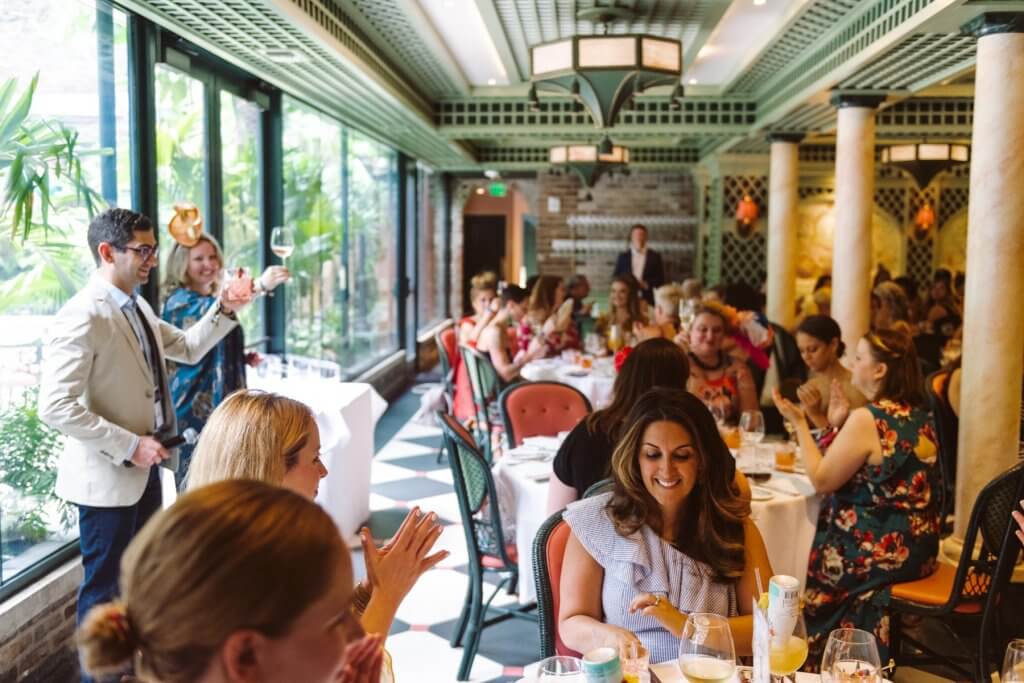
Tales of the Cocktail by Cory James Photo
Get Your Tickets
Please note that tickets for special events are sold individually, so you can build your own itinerary. You can also get day and week passes. The prix fixe tasting menus and food-pairing dinners are especially popular, and the tours and cocktail-themed parties also tend to sell out quickly, so we highly recommend getting your tickets as early as you can.
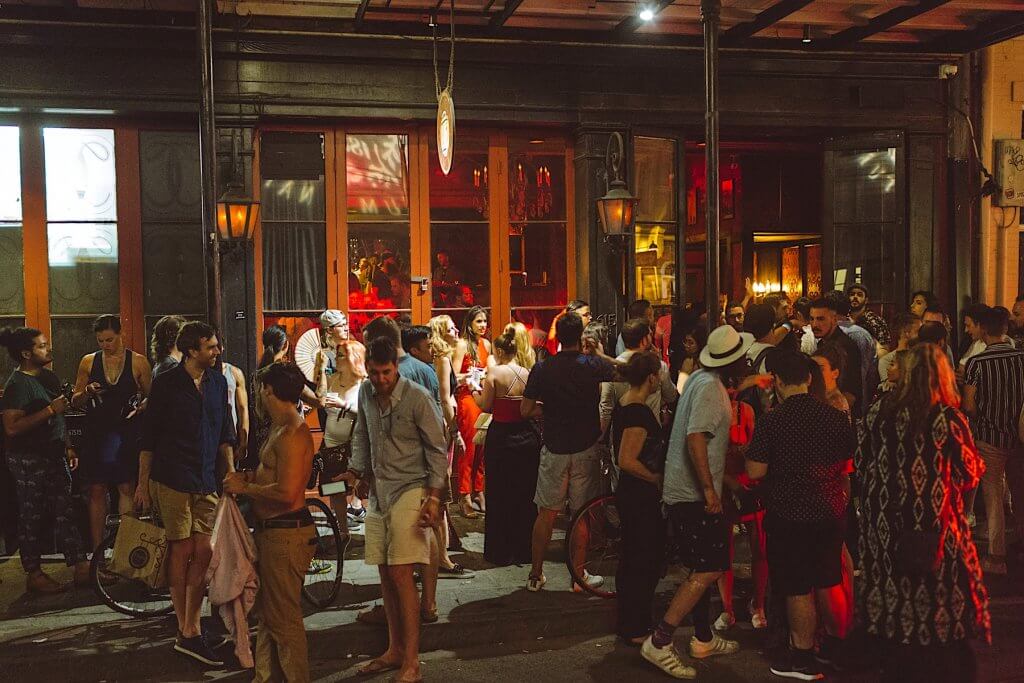
Tales of the Cocktail by Cory James Photo
What to Do and Where to Stay in the French Quarter
If you are looking for things to do in New Orleans, you will have no shortage of exciting options right at your fingertips. In addition to Tales of the Cocktail, there are many other exciting festivals and events taking place in The Big Easy in the summer, including culinary festivals.
Many of the Tales’ events are located in the French Quarter, so why not choose a historic hotel nearby? Check out these historic properties, all located in or near the French Quarter, some with charming saltwater pools.
Related Articles
JOIN THE NEWSLETTER!
Picnicking Along the Mississippi River This Summer
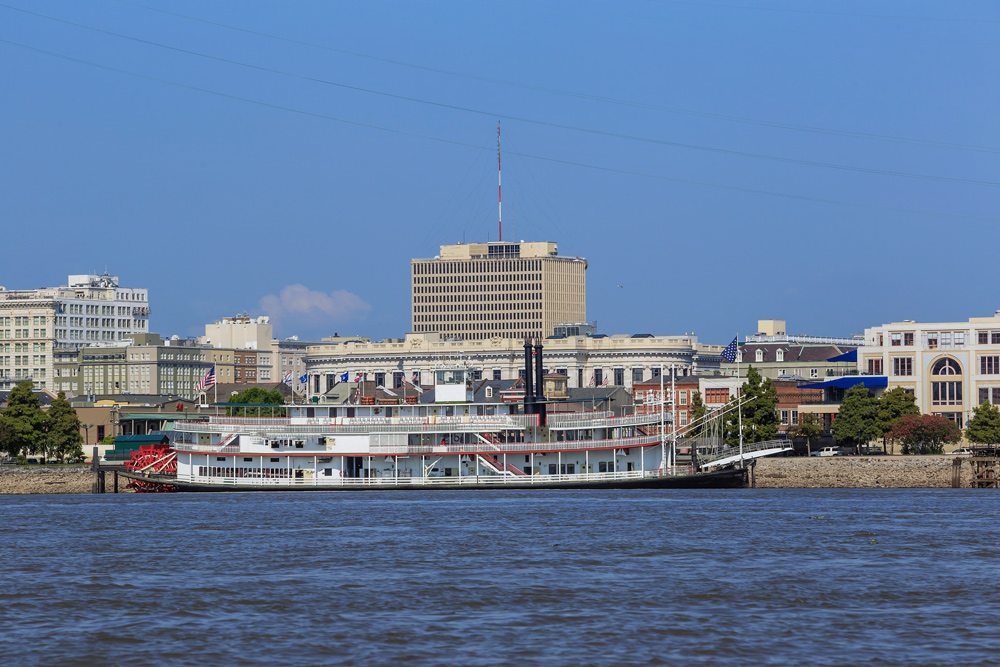
Summer in New Orleans brings warm breezes, longer days, and the perfect excuse to enjoy the outdoors — yes, despite all the heat and humidity. Whether you’re packing a homemade picnic basket or picking up local favorites like po-boys and fried chicken, the Riverfront offers some of the city’s most picturesque and relaxing spots to dine al fresco.
The Fly (Audubon Riverview Park)
From sprawling levees and oak-shaded lawns to scenic promenades with a view, here are the top places to enjoy a picnic by the Mississippi River in New Orleans this summer.
Tucked behind the Audubon Zoo Uptown, The Fly, officially known as Audubon Riverview Park, is a beloved picnic destination for locals. Sitting high on the levee, it offers expansive green space, sweeping views of the Mississippi River, and a relaxed vibe perfect for tossing a frisbee, walking your dog, reading under a tree, or simply watching the barges float by.
What makes The Fly extra special is its combination of natural beauty and urban charm. Spread out a blanket under the shade of a tree or take in a sunset as tugboats drift past. Grab a po-boy from nearby Domilise’s, a wood-fired pizza from Pizza Domenica, or some cold drinks and snacks from a local deli. With ample space and plenty of fresh air, it’s a picnic go-to for families, students, and couples alike.
Audubon Park
Just a short walk from The Fly is Audubon Park, a serene and sprawling greenspace that provides both open lawns and deeply shaded spots under centuries-old oak trees. It’s an Uptown gem, offering peace and quiet even in the heart of the city.
The park’s “Riverview” section along the river is especially ideal for a summer picnic. Whether you’re fueling up after a jog or meeting friends for a relaxing afternoon, Audubon Park’s scenic paths, benches, and open fields provide the perfect setting.
Before you head over, stop by Picnic Provisions & Whiskey or Stein’s Market & Deli to pick up gourmet sandwiches, charcuterie, a hoagie, or a chilled salad. Bring a blanket or use the park’s built-in picnic tables, and enjoy one of the most peaceful outdoor experiences in the city.
Crescent Park
For those who love urban scenery with its greenery, Crescent Park is a must. This 1.4-mile linear park along the Riverfront in the Bywater connects to the French Market and stretches all the way to the Marigny. With walking trails, picnic tables, native gardens, and shaded benches, it’s a modern outdoor space that blends nature with striking views of the New Orleans skyline and the mighty Mississippi.
At Crescent Park, you’ll find ample space to lay out a picnic blanket or settle into a shaded area. Watching the sun set behind the city’s bridges is an unforgettable way to end a summer evening.
Nearby food options include local haunts like The Joint for barbecue or Satsuma Café for light fare and juices. Whether you’re here for a romantic date or a family-friendly outing, the park’s accessible design and bike-friendly paths make it easy to enjoy.
The Batture
The Batture is a newly reimagined 10-acre space along the Mississippi River in Uptown New Orleans, where an old industrial site is being transformed into a welcoming destination for the public. Once home to the Bisso Marine salvage yard, this part of the riverfront has been off-limits for over a century. Now, it’s being opened up as a lively, green area where the community can reconnect with the river.
This new space is meant to feel distinctly New Orleans — casual, social, and tied to the rhythm of the river. Whether you’re enjoying a picnic at dusk, relaxing with a drink after biking the levee, or grabbing a bite with friends on the lawn, The Batture invites people to slow down and soak in the view. It’s a place for neighbors and families to gather, with a mix of open green space and local businesses that reflect the city’s charm and creativity.
You’ll find The Batture just steps from Audubon Park and The Fly, located between Walnut and Lowerline Streets. It’s easily reached via the levee from Leake Avenue. While nearby favorites like Broadway Beach and the levee dog park remain unchanged, The Batture adds something fresh to the neighborhood — a blend of restaurants, retail, office space, and wide-open lawns designed for enjoying the river in a relaxed, community-focused setting.
The first renovated buildings now house The Rigs Workspace, with a coffee shop and bar underway. Full-service restaurant spaces are also in the works. In the meantime, expect pop-up events, food trucks, and seasonal programming.
The Rigs Workspace is open daily to its members. For the public, The Batture is open Friday afternoons and evenings from 3 to 9 p.m., and on weekends from 9 a.m. to 9 p.m. The Crescent City Farmers Market is now open at The Batture every Tuesday from 8 a.m. to noon.
Please note that dogs are welcome but must stay leashed, and outside drinks are allowed, but no outside food.
Are you planning to spend some time in New Orleans soon? To stay close to all the action, book a historic boutique hotel in the French Quarter at FrenchQuarter.com/hotels today!
Related Articles
JOIN THE NEWSLETTER!
French Quarter Dining Al Fresco
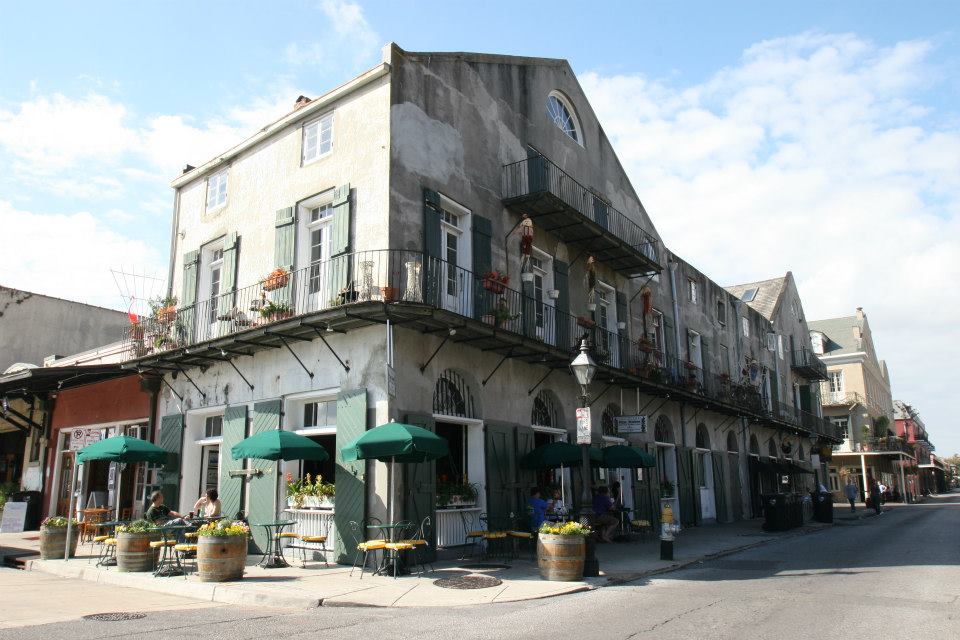
Photo courtesy of Louisiana Pizza Kitchen on Facebook
Despite its steamy reputation, the weather in New Orleans for most of the year is actually quite mild and pleasant. Winter days and summer nights and mornings often feel just as spring-like as an April afternoon.
With this abundance of great weather comes the ability and the desire to spend as much time outdoors as possible. Al fresco dining combines fine dining with a Sunday afternoon picnic, and the French Quarter has many restaurants and cafes that offer a breath of fresh air.
Mornings in the Quarter are filled with locals tending to their hanging gardens and shopkeepers preparing for the first customers of the day. Take a leisurely stroll to the Lower Quarter and visit the Croissant D’Or Patisserie, a charming European-style pastry shop with extremely reasonable prices. Enjoy fresh coffee, pastries, soups, salads, sandwiches, and quiches in a quiet courtyard or the shop’s tiled, old-world dining room.
Is it lunchtime? Louisiana Pizza Kitchen sits just steps outside of the French Market, with sunny sidewalk tables offering a welcome break from sightseeing and bargain hunting. Gourmet, wood-fired pizza is the specialty here, with ingredients such as sun-dried tomatoes, barbecue chicken, banana peppers, Portobello mushrooms, and even shrimp topping the unbleached flour or whole wheat crusts. Traditional toppings are also available for the less adventurous, as well as a large selection of appetizers, wood-fired sandwiches, fresh salads, and creative pasta dishes.
For those who prefer gumbo to gourmet, the Gumbo Shop offers all of the New Orleans favorites such as jambalaya, red beans and rice, crawfish etouffee, blackened fish, po-boys, and, of course, several varieties of gumbo. This busy restaurant has a small courtyard for dining outside of the packed main dining room, and prices are reasonable. Lunch is usually less crowded than dinner, and the central French Quarter location makes an easy mid-day stop during sightseeing or shopping.
Dinner in the French Quarter is superb cuisine served in historic and charming surroundings. Muriel’s offers these things and more in an opulently restored townhouse complete with balcony dining. French doors open the restaurant to Jackson Square, just steps away. Watch the French Quarter go by while enjoying dishes such as seafood gumbo, crawfish and goat cheese crepes, and wood-grilled selections such as filet mignon plus seasonal vegetables. For dessert, the vanilla bean crème brûlée is a standout.
Bayona Restaurant is also located in a beautifully renovated French Quarter home, but the surroundings are more intimate. Several small dining rooms and a romantic courtyard are available for dining on Chef Susan Spicer’s creations. The menu is subject to change, but expect impeccably executed Southern classics like grilled Gulf shrimp and sweetbreads.
Up on Decatur Street, towards the “bottom” of the Quarter and the beginning of the Marigny, Cane & Table serves Caribbean-inspired small and large plates and excellent cocktails, all deliverable in one of the Quarter’s great courtyards, a tropical-chic delight that makes us want to sip a negroni or a frozen paloma.
Whether it be a sunny spring morning, breezy fall afternoon or warm summer night, the French Quarter offers a bounty of al fresco dining options. The above suggestions are only the beginning — on almost every block you will find both quaint cafés and elegant bistros offering a chance to dine and soak up the classic Quarter atmosphere while actually becoming a part of it at a street-side table or balcony. Explore all the Quarter has to offer and find a favorite of your own.
Are you planning to spend some time in New Orleans soon? To stay close to all the action, book a historic boutique hotel in the French Quarter at FrenchQuarter.com/hotels today!
Related Articles
JOIN THE NEWSLETTER!
What to Do in July in New Orleans
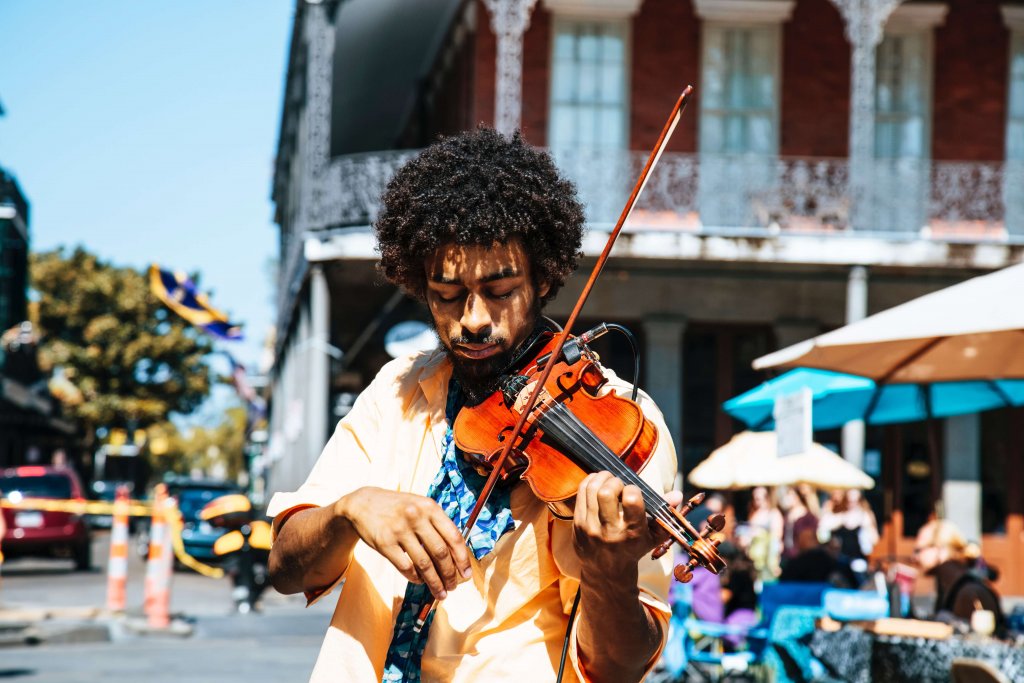
Photo by William Recinos on Unsplash
Summer in New Orleans is HOT, but we’ve got a slate of festivals that will cool you off and keep you entertained.
Independence Day
Friday, July 4, 2025
New Orleans celebrates July 4th like anywhere else in America, but with a flavor all her own. There will be fireworks above the Mississippi River and much partying as usual. As part of the annual “Go 4th on the River” celebration, the “Dueling Barges” will again put on a spectacular fireworks show set to patriotic music.
There are plenty of great spots to watch the display, but a French Quarter balcony is one of the most desired viewing spots in the city. You can grab excellent vantage points on the Riverfront, and in the Marigny and Bywater too. The Woldenberg Park on the shoreline of the Mississippi River is also an excellent spot to throw a picnic while you wait for the fireworks, as well as another waterfront park, Crescent Park. Coolers and chairs are welcome.
ESSENCE Festival of Culture
Thursday-Sunday, July 3-6, 2025
There’s a lot to love about the ESSENCE Festival of Culture, beyond the fact that it is the largest annual African American culture and music event in the world. It’s one of the finest gatherings of musicians in a city that is well-known for throwing together excellent gatherings of musicians.
Beyond the concerts held each night of the fest at the Superdome, its free daytime experiences at the Convention Center include motivational seminars, beauty and style presentations, celebrity interviews, cooking demonstrations with top chefs, and lots more.
Expect a stellar music lineup of major headliners and the best of the local talent. The festival’s theme is “Made Like This”. Notable performers include Boyz II Men, Jill Scott, Maxwell, Master P, GloRilla, The Isley Brothers, Nas, and Summer Walker. A tribute to Quincy Jones will be performed by Jermaine Dupri. This year, the festival is celebrating its 31st anniversary.
The traditional Sunday Gospel Celebration at the Convention Center will feature the greatest gospel hits, and ESSENCE After Dark, a series of late-night jam sessions, comedy shows, underground performances, live podcast recordings, and more, is returning once again to the Superdome.
Don’t wait! Get your tickets online. You can also download the festival’s app. And please remember that all events held at the Convention Center during the day are free and open to all (registration is required though for anyone over 18).
Bastille Day Fête
Friday, July 11, 2025
The Alliance Française de La Nouvelle-Orléans holds its annual celebration, which is an open-air evening of French music, culture, food, and community. There will be live music, a costume contest, kid-friendly activities, and French-centric food and wine. You can get tickets in advance on the event’s website.
San Fermin in Nueva Orleans (Running of the Bulls)
Friday-Sunday, July 11-13, 2025
Plenty of people know that Encierro de Pamplona is a major event in the Spanish tourism calendar, but not as many folks realize New Orleans hosts its own bull run. Except here, the “bulls” are roller derby girls, dressed in the traditional colors of Spain’s bull run and wearing horned helmets, who whack the participants — dressed all in white with red scarves and handkerchiefs — with wiffle bats.
This year, the Saturday, July 12, 2025, run takes place at the Gallier Hall, starting at 6:30 a.m. The annual El Txupinazo party takes place on Friday, July 11, 2025, from 6 to 9 p.m. This is a ticketed event and 18+ only.
Check out the schedule on the event’s website for the annual opening and closing parties happening that weekend. You can also get your tickets online.
Tales of the Cocktail
Sunday-Friday, July 20-25, 2025
Some of the world’s most famous cocktails were invented in this city: the Sazerac, Brandy Milk Punch, and Ramos Gin Fizz, to name a few. Having a drink in New Orleans isn’t just fun — it’s also a celebration of our unique history.
Still, New Orleans can’t just let a cultural touchstone be without holding a festival, and thus, Tales of the Cocktail, a celebration of mixed drinks in all of their vast diversity. Every year, the party draws in thousands of bar owners, distillers, mixologists, authors, tastemakers, and enthusiasts who are interested in networking, sharing knowledge, showing off their skills, learning, and, well, drinking.
This six-day event is filled with seminars, workshops, tastings, book signings, bartender contests, networking, and much more. The Tales’ 2025 theme is “Evolve,” and the festival’s signature annual blowout, the “best of” Spirited Awards, will be held on Thursday, July 24, 2025, followed by the always-popular after-party.
During the festival, Tales of the Cocktail hosts dozens of events. Please note that tickets for events are sold individually, so you can build your own itinerary. The prix fixe tasting menus and food-pairing dinners are especially popular, and the tours and cocktail-themed parties also tend to sell out quickly, so we highly recommend getting your tickets as early as you can.
Coming to New Orleans in July?
Check out our guide to where to stay in the French Quarter, and be sure to check out our resource for French Quarter Hotels. Also, consider booking a guided tour of St. Louis Cemetery No. 1 to experience the hauntingly beautiful past of New Orleans.
For easy, informative sightseeing, we recommend the City Sightseeing New Orleans city tour on the open-top, double-decker bus. It runs every 30 minutes through the Garden District, French Quarter, and CBD. You can hop on and off anytime!
Happy July!
Related Articles
JOIN THE NEWSLETTER!
What to Do on a Rainy Day in the French Quarter
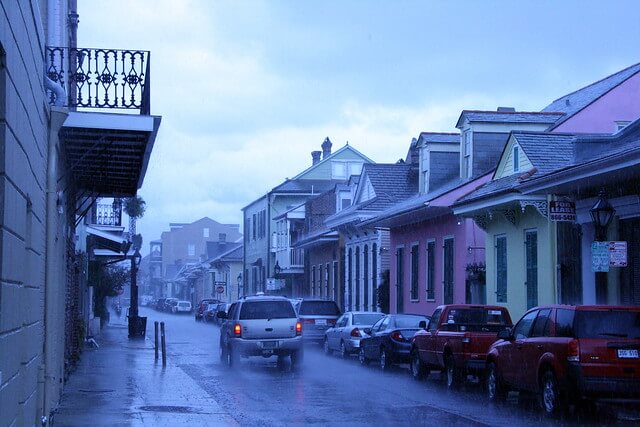
Photo by Vince Huang on Flickr
Rain, rain, go away? Not necessarily. It can rain buckets in New Orleans, seemingly suddenly, and especially during the long, steamy summer season in Louisiana. If you’re been caught in a daylong downpour or even a brief afternoon shower while visiting, do not worry — it’s easy to enjoy a few hours in the air-conditioned indoors in the French Quarter — just bring patience, your sense of adventure and appetite, and an umbrella (rain boots are also a good idea as the streets can flood). Here are our suggestions to keep you entertained until the sun comes out again.
Head to a Museum
The Quarter boasts quite a few museums, which tend to focus on the city’s past and the history of Louisiana. Some, like the New Orleans Jazz Museum, are free; others you can visit for a nominal fee.
For example, the New Orleans Pharmacy Museum is a reasonable $10 and features a permanent collection of 19th-century surgical instruments, books, patent medicines, and locally excavated bottles. The museum occupies a two-story historic building, the site of the apothecary shop of Louis Joseph Dufilho, Jr., who was America’s first licensed pharmacist. The museum’s second floor features a sick room and a physician’s study, and there’s a small yet lovely courtyard.
Hermann-Grima House and Gallier Historic Houses are two historic homes that are considered some of the best-preserved historic structures in the French Quarter. You can tour both and learn about what life was like in New Orleans in the 19th century for the Creole gentry as well as their enslaved servants.
The Historic New Orleans Collection is spread over several historic buildings in the French Quarter. The Royal Street location (520 Royal St.) houses the main museum with a permanent exhibit on state history, plus rotating exhibits on history and art. Admission is free.
Consider heading to Jackson Square for two museums and a historic cathedral. Catch a mass or free concert (or just admire the interior during the quiet hours) at the St. Louis Cathedral. It’s flanked by The Cabildo and The Presbytère, which are run by the Louisiana State Museum and house a number of excellent exhibits. You’ll find many precious pieces of Louisiana history at the Cabildo, like a rare Napoleon death mask and a painting of Marie Laveau by Frank Schneider.
There are two excellent permanent exhibits at the Presbytère. You could get lost for hours in the “Mardi Gras: It’s Carnival Time in Louisiana” exhibit, which details the history of Carnival traditions in Louisiana, including Cajun Courir de Mardi Gras, Zulu coconut throws, Rex floats, and spectacular costumes throughout the centuries. The “Living with Hurricanes: Katrina and Beyond” exhibit documents the natural disaster and ongoing recovery.
Go shopping
The Riverwalk Outlets and Canal Place are a short walk away from each other. Both are self-contained, multi-storied indoor malls that could keep you shopping and eating for as long as your stamina holds up. The Riverwalk mall is an outlet with more than 75 retailers and restaurants, including Nordstrom Rack and Cafe Du Monde. Canal Place is home to Saks Fifth Avenue, Tiffany and Co., Anthropologie, and dozens of other upscale retailers. There’s a small food court upstairs.
Another option is The Shops at JAX Brewery on the busy stretch of Decatur Street, a multi-story historic landmark that holds retail stores, cafes, restaurants, and a small museum dedicated to the brewery. Nearby, the historic French Market is a treasure trove of souvenirs, crafts, Louisiana spices and hot sauces, and more.
While you’re there, check out the Shops at the Colonnade. The strip of shops, some with Decatur and some with N. Peters St. addresses, is worth a visit if you’re shopping for souvenirs or local specialties like pralines. The whole stretch of the French Market is covered, from the flea market to the food vendor section, and you can easily duck in and out of the Shops at the Collonade even in the most inclement weather.
Relax with a book
New Orleans proudly boasts a number of impressively stocked independent bookstores, and some of the best ones are located in the Quarter. A former home of William Faulkner located in the historic and picturesque Pirate Alley, just off Jackson Square and behind the Cabildo, Faulkner House Books mostly offers local-interest books and the classics, including rare editions, and, of course, the works of William Faulkner.
Another beloved independent bookstore, and decidedly one of the best bookstores in New Orleans, the bi-level Beckham’s Bookshop specializes in used, antiquarian, and rare books, as well as CDs and vinyl. A gem of a place, Beckham’s has been around since 1979 at this location. It’s crammed floor to ceiling, and is beer- and dog-friendly. You’ll find it right across the street from the House of Blues.
The charming Dauphine Street Books and Crescent City Books are both great spots if you want to browse an eclectic, well-curated selection of both new and used books, including maps and out-of-print editions.
See a movie
The Prytania Theatre is located inside Canal Place. It’s the longest-operating movie theater in the South, and this location is its latest.
Visit the Aquarium and/or the Insectarium
The Audubon Aquarium is a sprawling compound on the Riverfront that will keep you and your family enthralled for hours. It was renovated in 2023, reopening after the Audubon Insectarium had moved in. Both are packed with state-of-the-art exhibits, some brand new. One ticket gets you admission to both attractions.
Take in a show
With the beautifully renovated Saenger and Joy theaters, Canal Street shines once again as a performing arts destination. See a Broadway show at the palatial Saenger, built in 1927 and restored in 2013 after staying vacant post-Katrina. Or catch a live music show or a national standup comedy act at the Joy Theater. This 1946 landmark started off as a movie theater and was gorgeously restored to its art deco glory.
Just off Jackson Square, Le Petit Theatre has called its St. Peter Street location home since 1922. See what’s playing this season at the famed playhouse here.
Eat and drink, of course
When it comes to those two activities in the French Quarter, the world is your oyster and the options are overwhelmingly, deliciously numerous. Whether you’re on a quest to sample the New Orleans staples, or want to experience some classic fare on a budget, you’ll find that some of the best bars and restaurants in the city (and the country, if not the world) could be found in the French Quarter, steps away from your hotel.
And what could be better than holing up with a drink and watching the rain? All year round, the Quarter offers incredible happy hour deals you won’t want to miss. Just to name a couple, Vacherie’s happy hour (3-6 p.m. every day) offers a $7 bar menu of draft beer flights, house wine, and mixed drinks, plus $9 small plates like sliders and boudin balls. And The Bombay Club inside Prince Conti Hotel specializes in martinis and has more than 50 specialty cocktails on the menu.
Rain or shine, happy exploring! And if you’re planning a stay in New Orleans, be sure to check out our resource for French Quarter Hotels.
Related Articles
JOIN THE NEWSLETTER!
Have a Feast During Restaurant Week New Orleans
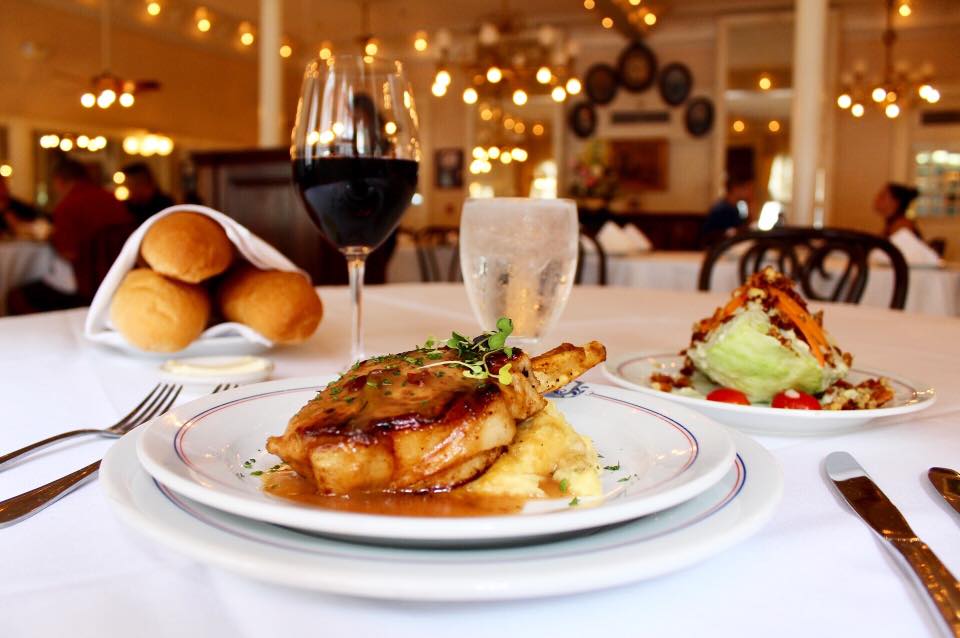
Photo courtesy of Antoine’s Restaurant on Facebook
Not that we need any encouragement to eat — and eat well, in this city — but the dining deals don’t start and end with COOLinary. New Orleans is heading into Restaurant Week, with 98 restaurants listed as participants this year.
Between Monday, June 16, and Sunday, June 22, 2025, local restaurants will be dishing out prix fixe lunches, brunches and dinners. Some menus offer two-course meals, others are three-course: typically a choice of an appetizer, a choice of an entree, and a choice of dessert. (Prices are per person and do not include beverages, tax or gratuity.)
Just like COOLinary, which runs for the whole month of August, Restaurant Week is a citywide promotion designed to lure diners, both local and those visiting, to increase patronage at restaurants across the city. As a result, there’s no better time to try out a new restaurant or revisit an old favorite. It’s also a chance to cross an iconic white-tablecloth establishment off your bucket list.
Restaurant Week New Orleans is sponsored by the Louisiana Restaurant Association’s Greater New Orleans Chapter and New Orleans & Company. And, just like COOLinary, its popularity is steady. Participating restaurants are spread all over the city, including the Marigny, Tremé, CBD, Uptown, Mid-City, the French Quarter, and Metairie, and run the gamut from iconic fine dining to neighborhood bistros.
This includes the famous Commander’s Palace, Galatoire’s, Muriel’s Jackson Square, and Tujague’s. Some more casual participants include Katie’s Restaurant & Bar and Boswell’s Jamaican Grill in Mid-City, and Mother’s Restaurant and Willa Jean in the CBD.
Mouth-watering concoctions on the menus across the city this June include the French Quarter’s grand dames and longtime COOLinary and Restaurant Week participants Antoine’s and Arnaud’s. Sampling their sophisticated French Creole prix fixe menus would be a gift to a visitor or a local alike.
Antoine’s, being in business for close to 200 years, knows how to do oysters — raw, charbroiled, Bienville, Rockefeller, or Thermidor — serving them alongside such local classics as soft shell crab. Antoine’s Restaurant Week weekend two-course brunch will set you back $36, and the weekday three-course dinner is $56. Both feature several bottomless drink options like mimosas for an additional price.
There are many highlights to choose from high-end, iconic local establishments like Galatoire’s (three-course $56 dinner), Cafe Degas ($28 two-course lunch, or three-course each $38 brunch and $45 dinner), and Ralph’s on the Park ($36 two-course brunch and $25 two-course lunch).
For more casual fare, try the three-course $32 dinner at Domenica or two-course $25 lunch Willa Jean. You can view all Restaurant Week menus and make reservations on the event’s website.
So, visit your old favorites, discover new ones — and enjoy some of the best, most refined cuisine this city has to offer — at a bargain price! Bon appetit!
Find a great French Quarter hotel and book your stay for Restaurant Week at www.frenchquarter.com/hotels/.
Related Articles
JOIN THE NEWSLETTER!
Get the Most Out of the French Quarter Fest
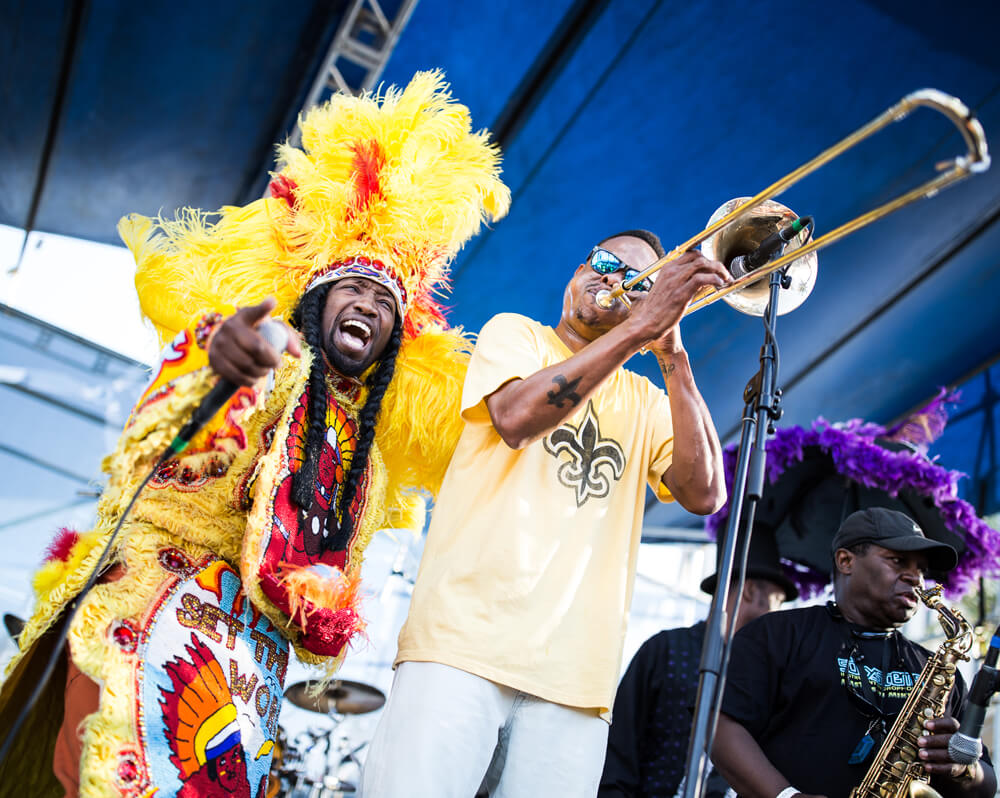
Photo by Zack Smith Photography. Courtesy of French Quarter Festivals, Inc.
French Quarter Fest is back, baby! And it’s its 42nd anniversary, no less. For four days (Thursday, April 10 through Sunday, April 13, 2025), a big chunk of the French Quarter — also known as the Vieux Carré, French for the “old square” (or “old quarter”) — will be transformed into a series of festival stages, each showcasing a different brand of music either rooted in or heavily influenced by, the sounds of Louisiana. Here’s a quick look at what you need to know about French Quarter Fest 2025.
Stage & Music Lineup Highlights
Since 2023 welcomed more than 875,000 fans over four days, this year again expect the total of 22 stages with over 300 performances scheduled. You can find the lineup by stage and, at the same time, by day on the event’s website. The performers are too numerous to mention, but the highlights are the best of what the city and the state have to offer, many of whom have performed at the festival before. There are, of course, artists from elsewhere, and a few newcomers.
We are excited about the music lineup every year, and this year is not exception. Come see Bruce Daigrepont Cajun Band, Corey Ledet Zydeco & Black Magic, BeauSoleil featuring Michael Doucet, Kermit Ruffins & the Barbecue Swingers, The Dirty Dozen Brass Band, Bag of Donuts, Panorama Jazz Band, Anders Osborne, The Soul Rebels, Mardi Gras Indians, and a whole lot of brass, zydeco, blues, and much more.
In other words, the who-is-who of the local music scene is returning or joining this year. Expect beyond excellence when it comes to the French Quarter Fest music lineup.
Food Vendor Highlights
As in the previous year, expect a mouthwatering melting pot of traditional New Orleans dishes such as fried shrimp or catfish, stuffed crabs, locally brewed beers, meat pies, crawfish macaroni and cheese, and hot sausage po-boys. Beyond that, there will be plenty of global flavors.
There will be about 70 culinary vendors on site. Our favorite vendors that are returning include Jacques-Imo’s Cafe, Tujague’s Restaurant, Plum Street Snoballs, 14 Parishes Jamaican Restaurant, Pat O-Brien’s, Miss Linda the Yakamein Lady, Desire Oyster Bar, Morrow’s, Loretta’s Authentic Pralines, Addis NOLA, Cochon King BBQ, and many more.
This year, Chubbies Famous Fried Chicken will have its culinary debut at the festival. (See the full culinary lineup here.)
In addition, Mike’s Amazing Culinary Stage, located in Woldenberg Riverfront Park on the Kohlmeyer Lawn, will feature one-on-one interviews with iconic local chefs and culinary favorites, including Fritai NOLA, Southerns, 14 Parishes, Baroness, Smoke N Honey, and more. Hosted by renowned Chef Kevin Belton, the program will also feature Mike’s Amazing’s own Chef Eleazar Fuerte who will share signature recipes.
Special Events
Every year, the festival features special events. Here are the 2025 highlights.
The French Quarter Festival Kickoff Parade and Opening Day Ceremony
The annual parade is held this year on Thursday, April 10, at 10 a.m. The parade departs from the 200 block of Bourbon Street down to St. Ann Street, where it turns and makes its way to Jackson Square for the Annual Opening Day Ceremony.
Dance Classes
The French Market Traditional Jazz Stage and the Chevron Cajun-Zydeco Showcase will feature dancing and classes in traditional Jazz, 1920s Charleston, swing, Cajun jitterbug, and zydeco. Classes are taught by professional dancers and are free and open to the public. Check out the lesson schedule on the festival’s website.
Children’s STEM Zone
On Saturday and Sunday, families are invited to take a journey of discovery at the Chevron STEM Boat: A Voyage of Discovery.
French Quarter Fest After Dark
The festival offers nighttime programming at various local venues from 9 p.m. till midnight to keep the good times rolling after the last festival stage closes at 8 p.m.
Getting Around the Fest
Getting around the Fest should be fairly easy if you’re walking or biking. Parking will be limited, so arrive early and try these lots: French Market, 500 Decatur Street, 300 North Peters Street, 211 Conti Street, The Garage at Canal Place, plus street parking within walking distance.
We do suggest that instead of driving, you use RTA buses, streetcars, rideshare services bikes, cabs, or the ferry to get to the festival. In addition to increased traffic, some streets will be closed for the duration of the festival beginning at approximately noon until 8:30 p.m. (Those who live in the area will need to have access passes from the NOPD Eighth District Station.) The streets that will be closing are Iberville, N. Rampart, Dumaine, and Decatur.
A Few Facts About French Quarter Fest
Here are a few facts about the fest and what to expect this year:
- The Fest celebrates local music and represents every genre from traditional and contemporary jazz to R&B, New Orleans funk, brass bands, folk, gospel, Latin, Zydeco, classical, cabaret, and international. It’s a medley, and a great way to sample the local music scene.
- It debuted in 1984 as a way to bring residents back to the Quarter following the World’s Fair and extensive sidewalk repairs in the French Quarter.
- The Fest employs more than 1,800 local musicians, with over 60 local restaurants participating as culinary vendors.
- The food and beverage vendors are set up in several locations throughout the French Quarter: Jackson Square, the Jazz Museum at the Mint, JAX Brewery, and Woldenberg Riverfront Park.
- You can buy the official 2025 poster at one of the merch booths at the festival, as well as online.
- To streamline your music experience and navigation, you can download an app on the fest’s website (either for IOS or Android).
- The live-music hours every day of the festival are 11 a.m. to 8 p.m.
- No coolers and ice chests, please. Help keep the festival free by purchasing food and beverages at the festival.
- The festival is cashless. All booths accept major credit cards and digital payments. Need cash exchange? Visit Jax Lot (500 Decatur St.).
- And yes, the fest is free unless you opt to buy a pass for a VIP experience.
If you’re planning a stay in New Orleans, be sure to check out our resource for French Quarter Hotels.
Related Articles
JOIN THE NEWSLETTER!
Things to Do in New Orleans This April
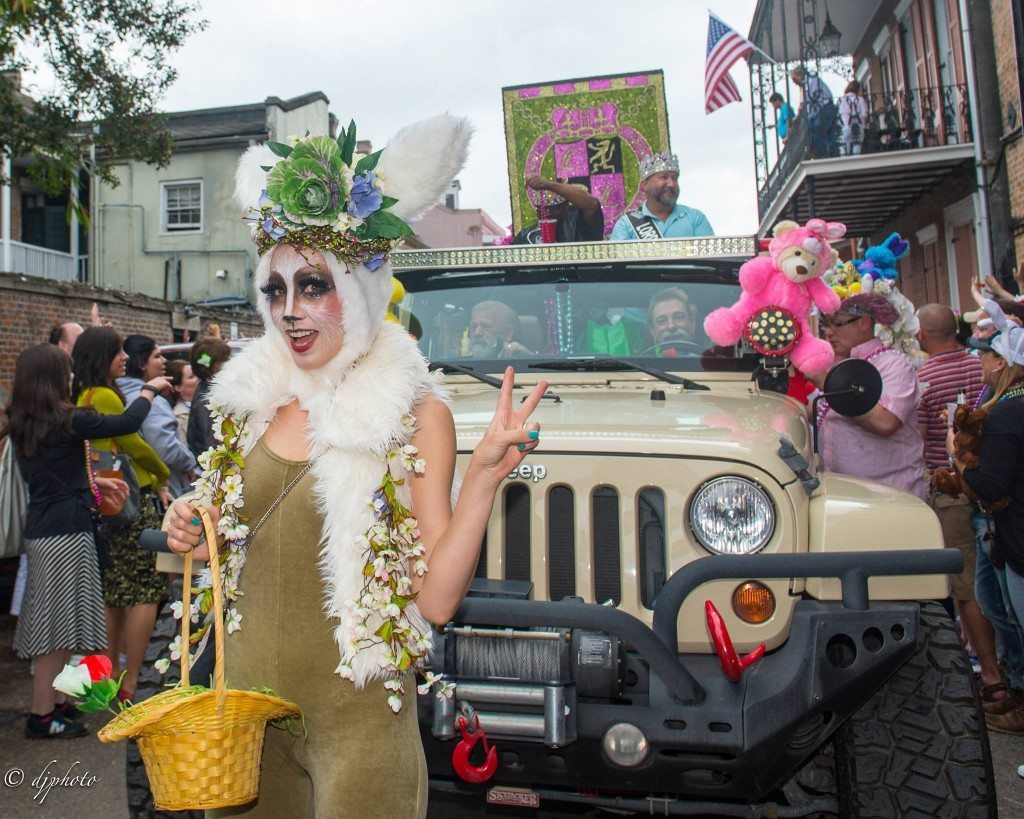
Photo by David Fary
April is one of our favorite months in New Orleans. Between the usually warm winters and super-hot summers, April sits in the New Orleans climatic sweet spot. It’s sunny and you can wear shorts on most days, but it’s not impossibly hot yet. Come evening, when the thermometer starts to dip into the 70s, the air feels something like perfect.
Then there are the festivals, of course. In New Orleans, April is considered the start of the festival season, which lasts from now into the dog days of summer. On almost every weekend (and during the mid-week as well), you’ll find outdoor concerts, parties, live performances, and general revelry just dripping out of the city.
Plus, spring just brings out the love in people. Folks get down, hang out, and are just that much more at ease. In a city nicknamed the Big Easy (you’ll never catch us using that term, but we accept it is a title New Orleans must live with), that’s saying something.
Oh, there’s one other great thing about April: crawfish. Sure, they’re usually in season by March, but April is when the boils really start becoming a common sight citywide.
Here’s how we do April.
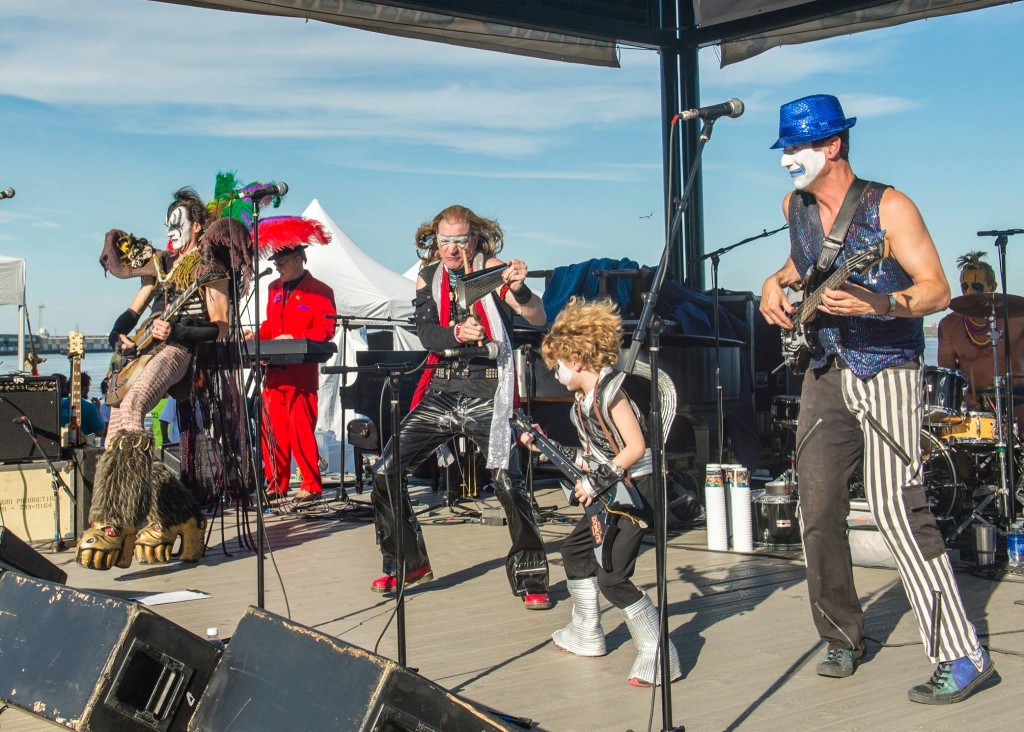
Bag of Donuts by David Fary
French Quarter Fest
French Quarter Festival is the largest free musical event in the New Orleans calendar, and according to organizers, the largest free music festival in the USA. For many, it has become a less crowded, less expensive alternative to the Jazz & Heritage Festival.
With that said, it’s not really fair to describe French Quarter Fest in relation to Jazz Fest. French Quarter Fest stands strongly on its own merits, rocking the city with a fantastic lineup of musicians and an unbeatable setting.
That setting is, as you may have guessed from the name, the French Quarter itself. Unlike so many music festivals around the world, French Quarter Fest eschews a huge grassy space for city streets. And in this case, said streets run through one of the world’s architectural preservation treasures. The festival goes off during the second weekend of April (April 10-13, 2025), which tends to come with gorgeous weather.
Despite featuring about 20 stages and a staggering amount of acts and food vendors, the fest is fairly easy to navigate. Here’s our guide to how to get the most out of the French Quarter Festival if you feel overwhelmed.
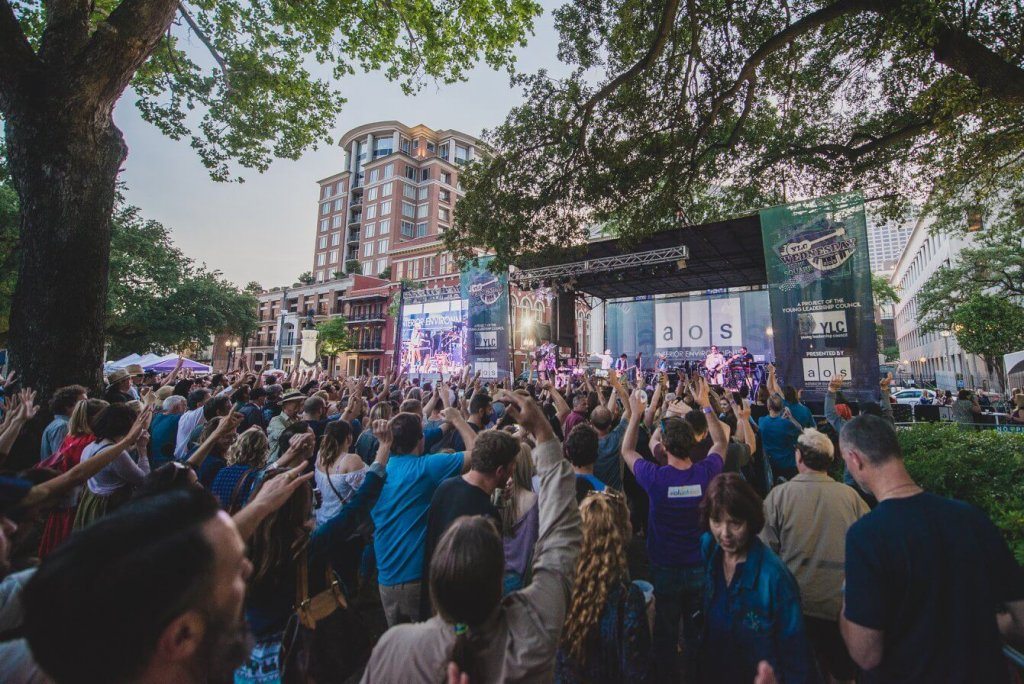
Photo courtesy of YLC Wednesday at the Square on Facebook
Wednesday at the Square
Free music? Good weather? Food stalls? Good folks? All this and more at Wednesday at the Square in downtown New Orleans, which continues for 10 weeks from March 19 through May 7, 2025. The concert series kicks off in Lafayette Square; music lasts from 5 to 8 p.m.
Photo courtesy of Crescent City Classic on Facebook
Crescent City Classic
This annual 10K run is one of the largest athletic events in New Orleans, partly because the race is open to all, and as a result tends to attract a wide swathe of runners, from casual beginners to world-class runners (many don a costume to run, this being New Orleans). You do have to register to run; the cost is $70 (less if you register before April 17, 2025).
Crescent City Classic is also notable for its route, which takes in some of the best cityscapes New Orleans has to offer. Runners take off from downtown in front of the Superdome, run through the French Quarter and the Tremé, then up Esplanade Avenue — one of the most beautiful streets in the nation — all the way to City Park.
If you’re around on the day of the run (Saturday, April 19, 2025), you’ll likely see crowds lining the route, but try not to drive anywhere near the running path, as roads will be blocked off.
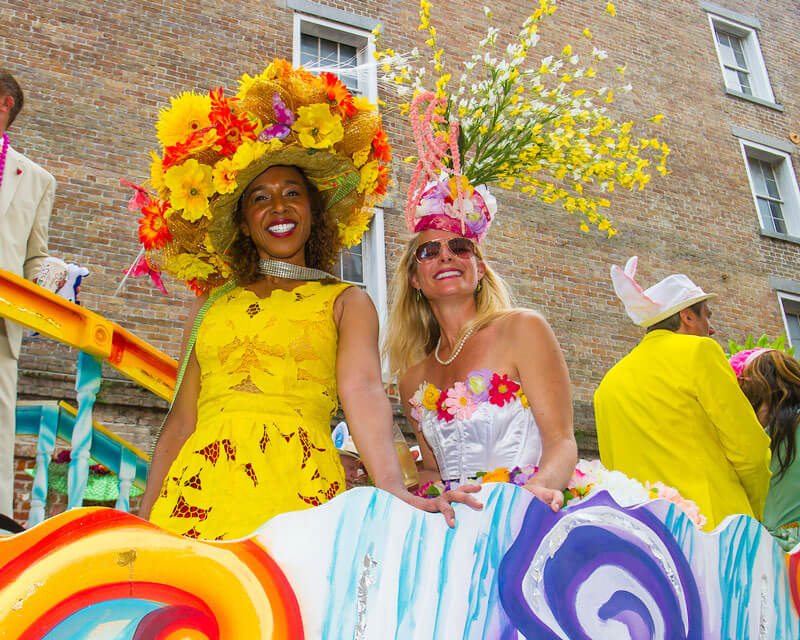
Photo by David Fary
Easter Parades
New Orleans is one of the most Catholic cities in the country, and it celebrates Easter in a big way, although that celebration isn’t always as traditional as one might guess. Long story short: When the 40-day Lent period of fasting ends, New Orleans says, “OK, that was enough self-denial” and throws three big parades. Why? Because New Orleans.
Starting at 11 a.m. on Easter Sunday (Sunday, April 20, 2025) with a hat contest and entertainment at the Omni Royal Orleans Hotel Ballroom, the French Quarter Easter Parade winds its way from there and back starting at 1 p.m. via classic convertible cars and mule-drawn carriages.
The the Chris Owens French Quarter Easter Parade is celebrating its 40th anniversary this year and will have a Great Gatsby theme to honor the late, great Chris Owens (she apparently expressed her wish to have this theme three years ago before her passing). Because it is now prohibited to parade on Bourbon Street (due to the terrorist attack on New Year’s Eve), the parade route will change and the details are still being ironed out.
The final parade of the day is the Gay Easter Parade, which rolls at 4:30 p.m. This one is also a family-friendly affair, and has been a long-standing tradition of the New Orleans LGBTQ+ community.
The paraders will march with floats and horse-drawn carriages, rolling by many of the French Quarter’s most storied gay businesses. Bring the kids to this one, as the Gay Easter Parade is famous for its generous throws and elaborate costuming.
Crawfest
One of the surest signs of spring in New Orleans is the presence of crawfish on menus and at boils across the city, and one of the surest signs that crawfish are back in season is Crawfest. Held on Saturday, April 5 this year, this party, sponsored by Tulane University, features some 20,000 pounds of crawfish, thousands of pounds of vegetables, two main stages, a bunch of bands, and a heavy student presence. This year, Rattlesnake Milk, Quarters of Change, Cardinal Bloom, Pocket Chocolate, Olivia Barnes, and Lost Bayou Ramblers are part of the lineup.
With that said, all are welcome — it costs $20 to get in, and kids 12 and under enter for free. (The fest is also free to Tulane students, with a wristband.) Crawfest kicks off on Tulane’s campus in Uptown, New Orleans.
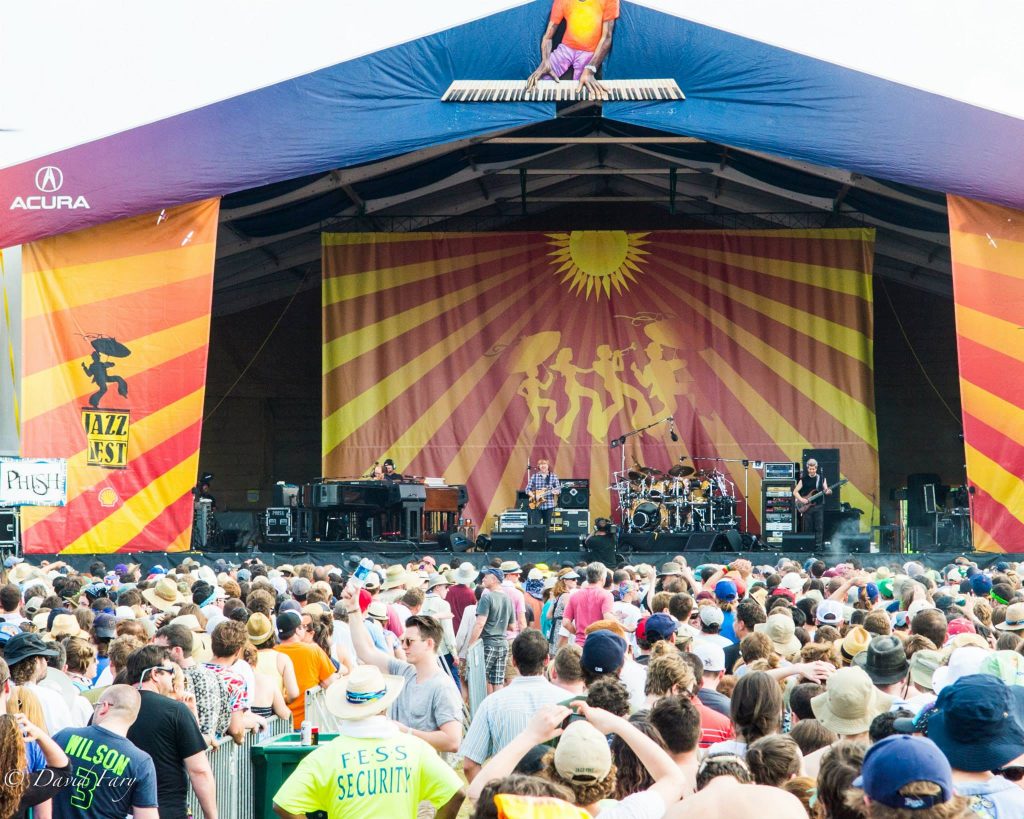
Photo by David Fary
Jazz Fest
The biggest music festival in the best music city in the USA is one of the marquee events of the New Orleans calendar. For the last weekend in April and the first weekend in May (April 24 – May 4, 2025), the city hosts hundreds of bands and thousands of tourists, who stream into the Fair Grounds Race Course from around the world.
Dozens of food vendors will show off the best of local cuisine, while artisans create and trade Louisiana crafts. On the days between the weekends, some of the world’s great musicians will be partying (and often, playing) all around the city.
The New Orleans Jazz & Heritage Festival is a giant event, and in some ways, all of the bands, shows and sheer entertainment options can feel intimidating. Yet once you find your favorite stage and preferred food vendors, and sit down with a cold drink and the breeze blowing across the Fair Grounds, it can also be very intimate — a means of annually connecting to New Orleans at a deep level that is exacerbated by the warm spring sun of April. For some tips, check out our First-Timer’s Guide to the New Orleans Jazz Fest.
If you’re planning a stay in New Orleans, be sure to check out our resource for French Quarter Hotels.


